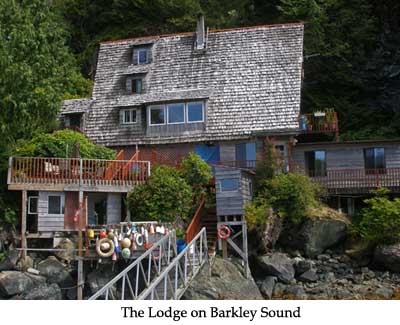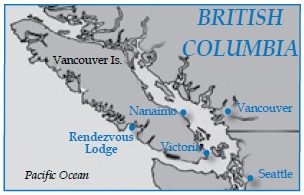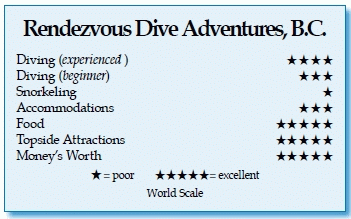Rendezvous Dive Adventures, British ColumbiaContents of this Issue: Rendezvous Dive Adventures, British Columbia Dive Stores in the Internet Age Did This Divemaster Commit Suicide, or Was She Silenced? Raja Ampat Liveaboard Goes Down in Flames Still Unclear How Key Largo’s Get Wet Got Wet A Computer for Non-Techie Divers How Divers Can Give Back: Part I Loving the Chambered Nautilus to Death Editorial Office: Ben Davison Publisher and Editor Undercurrent 3020 Bridgeway, Suite 102 Sausalito, CA 94965 a laid-back idyll on Vancouver Island for cold-water divers from the February, 2012 issue of Undercurrent
Dear Fellow Diver, As an experienced underwater photographer and certified solo diver, I'm used to taking my time and not worrying about a buddy. But in the unfamiliar 50-degree waters on the Pacific side of Vancouver Island in British Colombia, such thoughts take a back seat to safety. Peter Mieras, my Dutch-born host and skipper, stayed on the boat, so our checkout dive at Kyen Point was self-guided, navigating around twin underwater mounts topped by bull kelp. I was paired with a pleasant Swiss fellow who assured me that he also liked to go slow. Air temperatures hovered in the mid-60s, but the skies were gray. It was now down to business after Peter's thorough, illustrated briefing. We descended through a thick chocolaty layer that cleared around 25 feet. My buddy kept within 10 feet, letting me do my thing in the 35-foot visibility. I had dived these waters last year (the creatures were so amazing that I had to return), so seeing the giant sea cucumbers, spotted brown ratfish, beautiful white-spotted anemones, vermillion stars, spiny rose stars, fish-eating anemones, huge plumose anemones, China rockfish and the quillbacks felt like a return to a familiar, albeit edgy, neighborhood. And here was a freckled pale sea lemon nudibranch, an exquisite ascidian tunicate with tiny red spots looking like needlepoint against a cushiony white, and the humpbacked painted greenling. Then my buddy spotted a gray wolf eel poking its soccer ballsized head from under a ledge, looking like a grumpy old Muppet. Climbing back on board after 50 minutes, I felt I'd seen so many animals foreign to warm-water divers that I had already justified my trip.
Returning to the lodge (not to be confused with the Rendezvous Lodge on Vancouver Island's eastern side, near Campbell River), Peter said that a giant Pacific octopus nicknamed Gertrude was a house reef resident. We set off in search, but she wasn't in her usual haunts. There were plenty of other invertebrates: feather stars with their slender "feet" exposed, rainbow stars, sunflower stars seeming to glow from within their central disks, lots of giant dendrinotid nudibranchs and a pulsating, freeswimming scallop.
The diving was on a relaxed schedule, not governed by the tides. Unlike dive sites in the straits that race between Vancouver Island and the mainland, there was little or no current in Barkley Sound. I could wake up, grab a cup of coffee and shower around 7 a.m., enjoy a leisurely group breakfast at 8 a.m., then saunter down to the boat by 9 a.m. The rest of the day unfolded on its own. The next day on Diplock Reef, a complex structure about a quarter-mile southwest of Diplock Island, I collected images of red sea urchins, and a pudgy leather star, white with a pattern of regular radial red dots emanating from its central disk (which supposedly smells like garlic). A sad-faced cabezon draped over a rock appeared to be guarding its green eggs. A red- and white-banded scalyhead sculpin camped out next to a small group of hermit crabs and an opalescent nudibranch. A cluster of short white plumose anemone, interspersed with gooseneck barnacles, looked like a bouquet a newlywed mermaid would throw to her bridesmaids. After our surface interval, we dove Tyler Rock, where I spotted a chocolate-brown bat star with thick "bat wings" between its rays. The tentacles of a wildly pulsing, soccer-ball-sized fried-egg jellyfish were gripped by plumose anemones that would, it appeared, soon be ending its days. After a lunch at the lodge of sandwiches, a delightful lentil soup with lemon juice and sprinkled with feta cheese, and a dessert of coconut macaroons (homemade cookies topped every lunch), my dive buddy and his non-diving spouse went off kayaking. Peter and I again explored the house reef. I spied an orange longhorn decorator crab almost immediately, and a large cluster of light-bulb tunicates, transparent with a pink "glowing filament" within.
When we dove Renate's Reef on our third full day, I was hoping my buddy would help me spot the sixgill seen there by the prior week's group. Instead, I got a red Irish lord, a camouflage artist sporting a number of pink blotches that perfectly matched some nearby algae patches. On our way back, we rounded a small island across from the lodge, and watched harbor seals basking on shore. By 5:30 p.m., I was in the water again. The giant dendronotids were having a love-in, entwining their translucent bodies and laying eggs. My wide-angle Tokina proved its versatility, able to take whole body shots of giant sunflower stars, and close-focus wide angles of a decorated warbonnet. I loved the ease of our house dives, but the boat dives were cozy in their own way. All were made from the Rendezvous I, a 36-foot, fiberglass Canoe Cove driven by a 330-hp, single-screw Diesel with an easy-to-operate marine head and a full complement of safety gear. Inside the aging enclosed cabin, it was usually warm. Two tables were bordered by cushioned bench seats. With only six guests at any one time during my stay, the back deck offered plenty of room to gear up. The long dive ladder featured a platform that allowed a diver to rest knees or finned feet before climbing aboard. The boat made a fine, if slow, water taxi as it made the two-and-a-half-hour trip to and from our lodge via the fiord-like Alberni Inlet to Port Alberni. The ambiance at the Rendezvous was uniquely intimate in that guests spend their time in the close presence of Peter and his wife, Kathy, both in their 40s. Their love of diving, underwater photography and videography, and their good humor and unfailing courtesy made us feel like friends in a rented wilderness cabin. We shared wine at sundown and enjoyed Kathy's well-prepared dishes (dinners featured salmon, chicken and roast beef, and one night, a from-scratch vegetarian pizza followed by blueberries and raspberries sprinkled on ice cream for dessert). Then we viewed each other's photos, plus Peter's professional-quality video productions, on the couple's wide-screen TV. In between, I soaked up their travel stories and vivid descriptions of local marine life. Despite Peter's sometimes confusingly sarcastic remarks ("Did 'awful' mean 'bad' or 'good?') and my amazement that Kathy never failed to end most of her thoughts with a chuckle, I enjoyed their almost constant company. Not everyone did; one couple confided that they felt like they were living in a fishbowl with nowhere to hide. They left a day early. My non-diving spouse and I were suddenly the only guests. Would Peter and Kathy be reluctant to burn the fuel to take only one diver to sites 45 minutes away? Fellow readers, both of them took me out, tag-teaming boat handling and dive buddy duties. Indeed, a sultan's treatment aboard a private yacht, if you're okay with hanging out in a 36-footer with another couple in undergarments. Mealtimes became dinner with friends -- who did all the cooking and didn't ask for help with the cleanup. Peter said that those lucky enough to be there with a ratio of one staff per guest received the "royal treatment," often returning and bringing more friends. On my fourth day, I scored: I saw a giant Pacific octopus hiding in a crevice, peering out as I swam close, but not too close, to get a good image. Its one-inch-diameter suckers and thick arms looked strong enough to rip both my mask and camera away. Our last two dives were closer to the lodge, in order to be ready for a noon departure back to Port Alberni. The highlight was a free-swimming wolf eel, behavior Peter said he'd seen only some five times before. At the Rendezvous lodge, non-diving activities included boating to catch sight of the gray whales, humpbacks or orcas (none seen), kayaking, reading while enjoying the views off the deck, and dips in the hot tub. Walking on shore was a possibility. However, we were cautioned to take Reilly, the couple's black lab, with us if we decided to venture up the trails. On Vancouver Island itself, there is plenty to do and see; just get a good guide book. We stayed for one night at The Cottage, a superb bed and breakfast at Qualicum Beach on the Straits of Georgia. After the Rendezvous, we treated ourselves to a three-day stay at the pricy Wickaninnish Inn near artsy Tofino. I could have spent the entire visit exploring the tidal pools outside our window there. We spent a lot of time hiking in nearby Pacific Rim National Park. If you decide to eat at the Wick Inn's gourmet restaurant, make sure you make reservations far in advance, and specifically request a window table. From there, I could watch the mesmerizing play of the water on the rocks below. I can't predict whether you'll receive the same kind of idyllic experience or royal treatment I enjoyed at the Rendezvous Lodge. Then again, maybe a sixgill or a giant Pacific octopus named Gertrude might just say hello. -- S.P.
Coming up next issue: a liveaboard on the East Side of Vancouver Island. |

I want to get all the stories! Tell me how I can become an Undercurrent Online Member and get online access to all the articles of Undercurrent as well as thousands of first hand reports on dive operations world-wide
| Home | Online Members Area | My Account |
Login
|
Join
|
| Travel Index |
Dive Resort & Liveaboard Reviews
|
Featured Reports
|
Recent
Issues
|
Back Issues
|
|
Dive Gear
Index
|
Health/Safety Index
|
Environment & Misc.
Index
|
Seasonal Planner
|
Blogs
|
Free Articles
|
Book Picks
|
News
|
|
Special Offers
|
RSS
|
FAQ
|
About Us
|
Contact Us
|
Links
|
3020 Bridgeway, Ste 102, Sausalito, Ca 94965
All rights reserved.

 We ducked into a sheltered cove for lunch: homemade carrot puree soup, lunch meats
and cheeses to stuff between slices of sourdough bread. We then motored to Chup Point,
a pair of seamounts close to a plummeting shoreline, separated
by a boulder-strewn channel. Here I encountered the
first of many fried-egg jellyfish -- a yellow "yoke" in
the center. A black-clawed crab stared down the port of my
camera. White and purple tube-dwelling anemone flourished
their banded tendrils, and a predominantly black-eyed yellow
goby posed, unconcerned by my presence. Giant dendrinotid
nudibranchs, the length of my hand, seemed to erupt
geysers off their backs. Then there were the usual Pacific
Northwest suspects -- lingcod, delicate white feather
dusters and white-spotted kelp greenlings. Here and there,
a bright orange sea pen clung to the bottom.
We ducked into a sheltered cove for lunch: homemade carrot puree soup, lunch meats
and cheeses to stuff between slices of sourdough bread. We then motored to Chup Point,
a pair of seamounts close to a plummeting shoreline, separated
by a boulder-strewn channel. Here I encountered the
first of many fried-egg jellyfish -- a yellow "yoke" in
the center. A black-clawed crab stared down the port of my
camera. White and purple tube-dwelling anemone flourished
their banded tendrils, and a predominantly black-eyed yellow
goby posed, unconcerned by my presence. Giant dendrinotid
nudibranchs, the length of my hand, seemed to erupt
geysers off their backs. Then there were the usual Pacific
Northwest suspects -- lingcod, delicate white feather
dusters and white-spotted kelp greenlings. Here and there,
a bright orange sea pen clung to the bottom. After hanging my damp undergarments on
a line outside the kitchen (dive gear stayed
on the boat), I headed back to my tiny quarters
to change. There are five guest rooms and
two shared bathrooms, one with a shower. My
90-square-foot room barely held two twin beds
but it was clean, had a screened window overlooking
the bay, space for suitcases underneath
each bed, reading lights and some clothing pegs. Size didn't matter -- socializing
took place elsewhere, with meals at a common table, afternoons on the deck and evenings
in the living room. With only six guests, things felt relaxed more than crowded.
There was plenty of room to spread out. The main cabin was a large wooden A-frame, with
the hosts' bedroom on its own floor and guest rooms in the adjoining bunkhouse. A deck
stretched out along a lower level, roomy enough for a large, umbrella-topped table and
hot tub. A separate building housing tables, and lots of outlets could be used to set
up camera gear. The entire weathered-wood compound nestled against the side of a steep
tree covered hill, with steps down to a floating dock. Approaching from the water, I
saw a setting where some of J.R.R. Tolkien's kinder characters might happily reside.
After hanging my damp undergarments on
a line outside the kitchen (dive gear stayed
on the boat), I headed back to my tiny quarters
to change. There are five guest rooms and
two shared bathrooms, one with a shower. My
90-square-foot room barely held two twin beds
but it was clean, had a screened window overlooking
the bay, space for suitcases underneath
each bed, reading lights and some clothing pegs. Size didn't matter -- socializing
took place elsewhere, with meals at a common table, afternoons on the deck and evenings
in the living room. With only six guests, things felt relaxed more than crowded.
There was plenty of room to spread out. The main cabin was a large wooden A-frame, with
the hosts' bedroom on its own floor and guest rooms in the adjoining bunkhouse. A deck
stretched out along a lower level, roomy enough for a large, umbrella-topped table and
hot tub. A separate building housing tables, and lots of outlets could be used to set
up camera gear. The entire weathered-wood compound nestled against the side of a steep
tree covered hill, with steps down to a floating dock. Approaching from the water, I
saw a setting where some of J.R.R. Tolkien's kinder characters might happily reside. Our only real restrictions were
that we try to be back on board within
an hour, and all dives be no-deco and
non-solo. Tanks were filled to 3,000
psi, and most dives were less than 80
feet. Everyone wore drysuits, but some
divers had to abort or shorten their
bottom time for preventable reasons:
not weighted enough for salt water,
cold hands and a lack of stamina in
surface currents. With three-fingered dry mitts and three layers of undergarments, I was the only one who made three dives a
day. As it was late July, a dark, 25-foot-deep, halocline-prone surface layer made many
safety stops a weird visual experience. Missing the line meant a surface swim, making
me glad I came up with adequate reserves of air. Once when we missed the line, my buddy
proved himself by sticking with me as we off-gassed in near-blackout surface layer.
Our only real restrictions were
that we try to be back on board within
an hour, and all dives be no-deco and
non-solo. Tanks were filled to 3,000
psi, and most dives were less than 80
feet. Everyone wore drysuits, but some
divers had to abort or shorten their
bottom time for preventable reasons:
not weighted enough for salt water,
cold hands and a lack of stamina in
surface currents. With three-fingered dry mitts and three layers of undergarments, I was the only one who made three dives a
day. As it was late July, a dark, 25-foot-deep, halocline-prone surface layer made many
safety stops a weird visual experience. Missing the line meant a surface swim, making
me glad I came up with adequate reserves of air. Once when we missed the line, my buddy
proved himself by sticking with me as we off-gassed in near-blackout surface layer. Divers Compass: My diver/non-diver package for a five-night, allinclusive
stay for two totaled about $2,000, plus $230 for Canada's
sales tax, but bring your own booze; I added a 10 percent tip when
settling our bill to show my appreciation for the personal service,
shocking Peter as "too much" . . . I flew to Vancouver (you must
have a passport), then rented a car at the airport for around $50 per
day; gas was around $5 a gallon . . . the car ferry from Vancouver
Island to Nanaimo via ferry is around $90 each way, plus a $15 reservation
fee, and reservations are strongly advised during summer
months (
Divers Compass: My diver/non-diver package for a five-night, allinclusive
stay for two totaled about $2,000, plus $230 for Canada's
sales tax, but bring your own booze; I added a 10 percent tip when
settling our bill to show my appreciation for the personal service,
shocking Peter as "too much" . . . I flew to Vancouver (you must
have a passport), then rented a car at the airport for around $50 per
day; gas was around $5 a gallon . . . the car ferry from Vancouver
Island to Nanaimo via ferry is around $90 each way, plus a $15 reservation
fee, and reservations are strongly advised during summer
months ( 